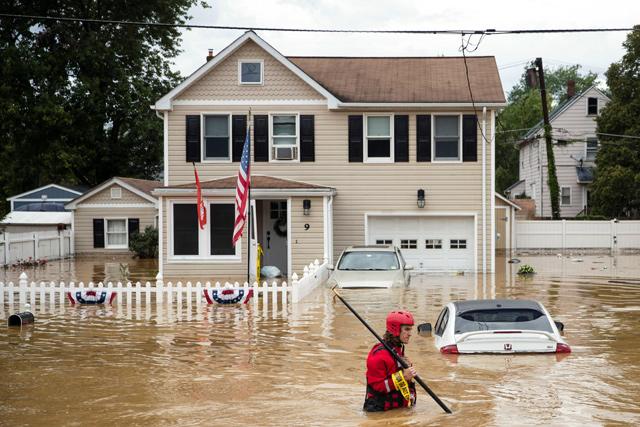- International News
- Tue-2021-08-24 | 03:38 pm

Nayrouz News Agency :
Tropical Storm Henri was downgraded to a tropical depression late Sunday after slamming into Rhode Island on the US east coast, knocking out power to thousands of Americans, uprooting trees, and bringing record rainfall.
The storm hit land near the town of Westerly, Rhode Island, at approximately 12:15 PM (16:15 GMT), the National Weather Service said. Henri had already been downgraded from a Category 1 Hurricane earlier on Sunday.
But the National Hurricane Centre (NHC) said in its 5:00 am (0900 GMT) advisory that Henri was "nearly stationary" and winds had reduced to 48 kilometres per hour, much lower than predicted gusts of 75 mph — with "little change in strength" forecast.
Henri is a rare tropical storm to strike America's northeastern seaboard and comes as the surface layer of oceans warms due to climate change.
The warming is causing cyclones to become more powerful and carry more water, posing an increasing threat to the world's coastal communities, scientists say.
Millions of residents in New England and New York’s Long Island had been told to prepare for violent winds, days without electricity and storm surges of up to 1.5 metres.
Rhode Island Governor Dan McKee said there was "significant flooding” in areas. There were no immediate reports of any casualties.
By mid-afternoon, the NHC had lifted all surge warnings and initial reports from residents indicated the storm was not as bad as projections feared although fallen trees nearly damaged homes in Groton, Connecticut.
"We dodged a bullet,” James Kiker, of Newport, Rhode Island, told AFP, saying he saw only "minimal damage” in his area, including a few broken branches.
Residents on Long Island, home to the plush Hamptons villages where wealthy New Yorkers retreat in summer, expressed relief that the storm’s path had skirted east of them.
"I will continue to stay alert as still plenty of wind, rain and surging seas await us but I am breathing a little easier,” Amy Pedatella, a 46-year-old property manager who spent Saturday securing seaside homes in the Hamptons, told AFP.
Emergency rescues
In Newark, New Jersey, flash flooding caused havoc with emergency services rescuing 86 people, including 16 children, from submerged vehicles.
In Helmetta, 48 kilometres south, volunteer firefighters waded through waist-deep water to help evacuate residents from waterlines rising dangerously close to their homes.
Some 79,000 people lost power in Rhode Island and another 33,000 suffered blackouts in Connecticut, according to the tracking website poweroutage.us.
More than 200 flights were canceled at Newark airport while New York’s LaGuardia and JFK airports cancelled almost 200 between them, they said.
President Joe Biden ordered the Federal Emergency Management Agency (FEMA), to coordinate disaster relief efforts in Rhode Island, Connecticut, and New York, where Governor Andrew Cuomo deployed 500 national guard soldiers.
"We’re doing everything we can now to help those states prepare, respond and recover,” he told reporters.
Henri missed New York City by several miles but still caused tropical storm conditions overnight and throughout Sunday, where a flash flood warning was in effect until 5:45pm.
Concert abandoned
Rain late Saturday forced New York to halt a star-studded Central Park concert billed as a "homecoming” for a metropolis hard hit by the pandemic.
An announcer cut off pop legend Barry Manilow mid-song to urge revelers to proceed swiftly but calmly to the nearest exit.
The National Weather Service said 4.9 centimetres of rain fell in the park between 10:00pm and 11:00pm on Saturday, the wettest hour on record in the city of eight million people.
By the time it blows out, Henri is expected to have produced three to 7.5 to 15 centimetres of rain across the region, with isolated maximum totals near 30 centimetres, the NHC said.
Before the downgrade, Henri was set to be the first hurricane to hit New England in 30 years. Hurricane Bob in 1991 killed at least 17 people.
The warnings also reignited memories of Hurricane Sandy, a more powerful storm that knocked out power for much of Manhattan and flooded subways in 2012.













